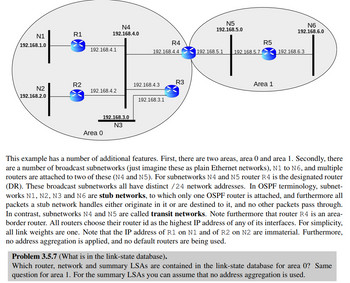
Database System Concepts
7th Edition
ISBN: 9780078022159
Author: Abraham Silberschatz Professor, Henry F. Korth, S. Sudarshan
Publisher: McGraw-Hill Education
expand_more
expand_more
format_list_bulleted
Concept explainers
Question
thumb_up100%
Can someone please help me with problem 3.5.7? I'll give a thumb up to thank for your time.
As I'm reviewing for my upcoming exam, I really need an answer from an expert in the field.
Please do not send me an answer from chatGPT. I've got enough of that, so please be helpful. Thank you.

Transcribed Image Text:N1
192.168.1.0
N2
192.168.2.0
R1
R2
N4
192.168.4.0
192.168.4.1
192.168.4.2
192.168.3.0
N3
Area 0
192.168.4.4
192.168.4.3
R4
192.168.3.1
R3
N5
192.168.5.0
192.168.5.1 192.168.5.7
R5
Area 1
N6
192.168.6.0
192.168.6.3
This example has a number of additional features. First, there are two areas, area 0 and area 1. Secondly, there
are a number of broadcast subnetworks (just imagine these as plain Ethernet networks), N1 to N6, and multiple
routers are attached to two of these (N4 and N5). For subnetworks N4 and N5 router R4 is the designated router
(DR). These broadcast subnetworks all have distinct /24 network addresses. In OSPF terminology, subnet-
works N1, N2, N3 and N6 are stub networks, to which only one OSPF router is attached, and furthermore all
packets a stub network handles either originate in it or are destined to it, and no other packets pass through.
In contrast, subnetworks N4 and N5 are called transit networks. Note furthermore that router R4 is an area-
border router. All routers choose their router id as the highest IP address of any of its interfaces. For simplicity,
all link weights are one. Note that the IP address of R1 on N1 and of R2 on N2 are immaterial. Furthermore,
no address aggregation is applied, and no default routers are being used.
Problem 3.5.7 (What is in the link-state database).
Which router, network and summary LSAs are contained in the link-state database for area 0? Same
question for area 1. For the summary LSAs you can assume that no address aggregation is used.
Expert Solution
This question has been solved!
Explore an expertly crafted, step-by-step solution for a thorough understanding of key concepts.
Step by stepSolved in 4 steps

Knowledge Booster
Learn more about
Need a deep-dive on the concept behind this application? Look no further. Learn more about this topic, computer-science and related others by exploring similar questions and additional content below.Similar questions
- Thank you! How would you do it without using ex falso quodlibet?arrow_forwardKevin is looking for information on two different topics using a Boolean operator. Kevin needs to use which Boolean operator to get the right search results.arrow_forwardDon't just say that deep access is better because it works better; explain why deep access is better from a programmer's point of view.arrow_forward
arrow_back_ios
arrow_forward_ios
Recommended textbooks for you
 Database System ConceptsComputer ScienceISBN:9780078022159Author:Abraham Silberschatz Professor, Henry F. Korth, S. SudarshanPublisher:McGraw-Hill Education
Database System ConceptsComputer ScienceISBN:9780078022159Author:Abraham Silberschatz Professor, Henry F. Korth, S. SudarshanPublisher:McGraw-Hill Education Starting Out with Python (4th Edition)Computer ScienceISBN:9780134444321Author:Tony GaddisPublisher:PEARSON
Starting Out with Python (4th Edition)Computer ScienceISBN:9780134444321Author:Tony GaddisPublisher:PEARSON Digital Fundamentals (11th Edition)Computer ScienceISBN:9780132737968Author:Thomas L. FloydPublisher:PEARSON
Digital Fundamentals (11th Edition)Computer ScienceISBN:9780132737968Author:Thomas L. FloydPublisher:PEARSON C How to Program (8th Edition)Computer ScienceISBN:9780133976892Author:Paul J. Deitel, Harvey DeitelPublisher:PEARSON
C How to Program (8th Edition)Computer ScienceISBN:9780133976892Author:Paul J. Deitel, Harvey DeitelPublisher:PEARSON Database Systems: Design, Implementation, & Manag...Computer ScienceISBN:9781337627900Author:Carlos Coronel, Steven MorrisPublisher:Cengage Learning
Database Systems: Design, Implementation, & Manag...Computer ScienceISBN:9781337627900Author:Carlos Coronel, Steven MorrisPublisher:Cengage Learning Programmable Logic ControllersComputer ScienceISBN:9780073373843Author:Frank D. PetruzellaPublisher:McGraw-Hill Education
Programmable Logic ControllersComputer ScienceISBN:9780073373843Author:Frank D. PetruzellaPublisher:McGraw-Hill Education

Database System Concepts
Computer Science
ISBN:9780078022159
Author:Abraham Silberschatz Professor, Henry F. Korth, S. Sudarshan
Publisher:McGraw-Hill Education

Starting Out with Python (4th Edition)
Computer Science
ISBN:9780134444321
Author:Tony Gaddis
Publisher:PEARSON

Digital Fundamentals (11th Edition)
Computer Science
ISBN:9780132737968
Author:Thomas L. Floyd
Publisher:PEARSON

C How to Program (8th Edition)
Computer Science
ISBN:9780133976892
Author:Paul J. Deitel, Harvey Deitel
Publisher:PEARSON

Database Systems: Design, Implementation, & Manag...
Computer Science
ISBN:9781337627900
Author:Carlos Coronel, Steven Morris
Publisher:Cengage Learning

Programmable Logic Controllers
Computer Science
ISBN:9780073373843
Author:Frank D. Petruzella
Publisher:McGraw-Hill Education